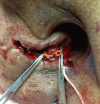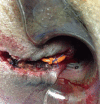Application of advancement flap after loose seton placement: a modified two-stage surgical repair of a transsphincteric anal fistula
- PMID: 25210689
- PMCID: PMC4155139
- DOI: 10.3393/ac.2014.30.4.192
Application of advancement flap after loose seton placement: a modified two-stage surgical repair of a transsphincteric anal fistula
Abstract
Purpose: A number of techniques have been described for the treatment of a transsphincteric anal fistula. In this report, we aimed to introduce a relatively new two-stage technique, application of advancement flap after loose seton placement, to present its technical aspects and to document our results.
Methods: Included in this retrospective study were 13 patients (10 males, 3 females) with a mean age of 42 years who underwent a two-stage seton and advancement flap surgery for transsphincteric anal fistula between June 2008 and June 2013. In the first stage, a loose seton was placed in the fistula tract, and in the second stage, which was performed three months later, the internal and external orifices were closed with advancement flaps.
Results: All the patients were discharged on the first postoperative day. The mean follow-up period was 34 months. Only one patient reported anal rigidity and intermittent pain, which was eventually resolved with conservative measures. The mean postoperative Wexner incontinence score was 1. No recurrence or complications were observed, and no further surgical intervention was required during follow-up.
Conclusion: The two-stage seton and advancement flap technique is very efficient and seems to be a good alternative for the treatment of a transsphincteric anal fistula.
Keywords: Anal fistula; Flap; Seton; Surgery.
Conflict of interest statement
No potential conflict of interest relevant to this article was reported.
Figures




References
-
- Sainio P. Fistula-in-ano in a defined population: Incidence and epidemiological aspects. Ann Chir Gynaecol. 1984;73:219–224. - PubMed
-
- Marks CG, Ritchie JK. Anal fistulas at St Mark's Hospital. Br J Surg. 1977;64:84–91. - PubMed
-
- George Pinedo M, Caselli MG, Urrejola SG, Niklitschek LS, Molina PM, Bellolio RF, et al. Modified loose-seton technique for the treatment of complex anal fistulas. Colorectal Dis. 2010;12(10 Online):e310–e313. - PubMed
-
- Isbister WH, Al Sanea N. The cutting seton: an experience at King Faisal Specialist Hospital. Dis Colon Rectum. 2001;44:722–727. - PubMed
LinkOut - more resources
Full Text Sources
Other Literature Sources

